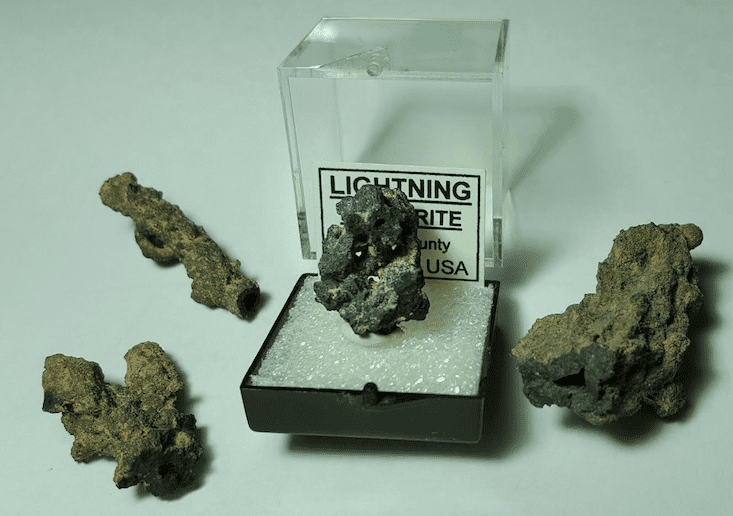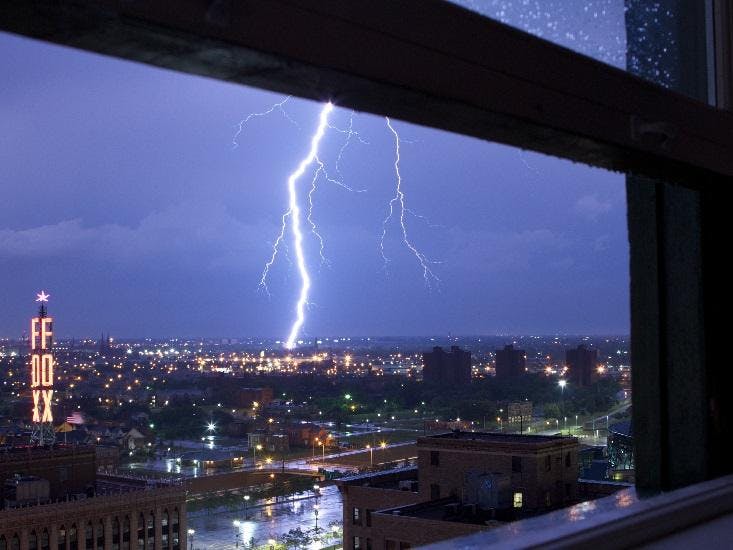It was a rainy, early summer day in the Hamptons, a few years before the First World War. Robert W. Wood, a physicist (and later a science fiction writer) engaged in optics research at Johns Hopkins University, was out on his lawn spending time with his family when he had a close encounter with a lightning bolt. The ground ignited, producing a smoky column about seven feet high. Rather than being repelled by the situation, he later described it in a letter to Nature as a “fortunate accident”—he had “hit upon a way of extending our knowledge of these curious autographs of thunderbolts.”
The autographs in question were fulgurites (fulgur is an old Latin word for lightning). Although they were at one point thought to be hardened gunk released from plant roots, we now know that these roughly cylindrical pieces of glass form when lightning travels from a cloud to Earth’s surface and penetrates the ground. Prior to dissipating, the subterranean electrical current rapidly heats the sand, clay, and rocks through which it flows, causing them to melt and even boil. The resulting fulgurites are usually hollow, due to the vaporization of a core of soil along the current’s underground path. Their exterior often has a gnarled, rough appearance caused by the incomplete fusion of soil particles; the interior, however, where higher temperatures induce more melting, is usually smooth. (There are deviants, of course. Case in point, from Etsy: “This rare Lightning Fulgurite has 3 holes going all the way through that totally resemble eyes and a mouth where the light shines through and it is rumored to look like Jesus’s face. He also has a beard.”)

Walking over to where the lightning struck his lawn, Wood found two small holes. He filled the larger of the two with melted solder, later excavating a nearly 4-foot-long fulgurite cast covered in patches of fused sand grains. Wood believed casting fulgurites from holes provided a useful means of studying both the fulgurites and the lightning bolts that created them. But it turns out there is an even more straightforward method available, according to a study published last month in Scientific Reports.
Lightning passing through a meter of quartz sand has an average energy of about one megajoule, or roughly the amount of energy contained in a shot-glass worth of gasoline.
The study’s authors, Matthew A. Pasek, a geoscientist at the University of South Florida, and Marc Hurst, a geologist at Independent Geological Services, gathered fulgurites previously formed in exposed areas of quartz sand being mined along the Lake Wales Ridge, in Polk County, Florida. These sands have long been exposed to lightning storms, ensuring a high density of fulgurites ripe for the picking. Having been constructed entirely from silica-rich sand, they were considerably better developed than the patches of fused sand grains Wood recovered from the soil beneath his lawn.
The researchers were interested in how the hollow tubes of glass store information about the characteristics of lightning strikes. Specifically, they examined the shape of fulgurites to learn more about the amount of energy a lightning strike transfers to the ground after its journey from the clouds. After collecting 266 fulgurites—totaling a length of 14.66 meters—Pasek measured the internal diameter of each one to calculate approximately how much energy per unit of length had passed through it (lightning passing through a meter of quartz sand has an average energy of about one megajoule, or roughly the amount of energy contained in a shot-glass worth of gasoline).
Their approach adds a new tool to the kit for scientists looking to study lightning. Other methods involve either inducing strikes via lasers or wires carried up into the clouds by rockets, or tall structures, such as the CN Tower in Toronto, Canada, as lightning rods. Fulgurite analysis, though, is notable for its directness: By taking advantage of a stable product of lightning, it can establish the amount of energy transferred through a solid material by a strike, and thus the damage it can cause. What’s more, fulgurites can contribute to our understanding of past environmental conditions. For example, analysis of gases trapped in bubbles within an ancient fulgurite from the Libyan Desert indicated the area had a semi-arid climate (was home to grass and shrubs) around 15,000 years ago, in agreement with other lines of evidence, like pollen and plant macrofossils.
Fulgurites have even made it into the hallowed pages of YouTube. Most videos show fulgurites being fashioned out of sand with the help of a high voltage power supply—but one user, Bill Gilmour, found out something that every home fulgurite maker will want to know: Kitty litter is especially well-suited to the task.
Chris Drudge is a science writer from Canada. Follow him on Twitter @RosinCerate.
The lead photograph is courtesy of Kevin Madden via Flickr.



